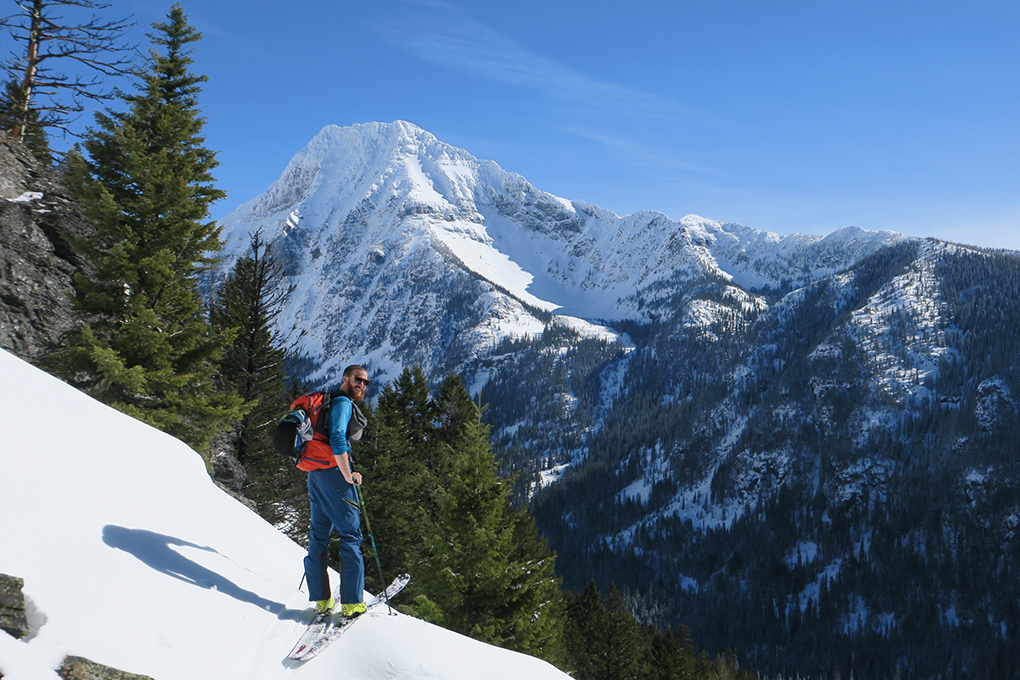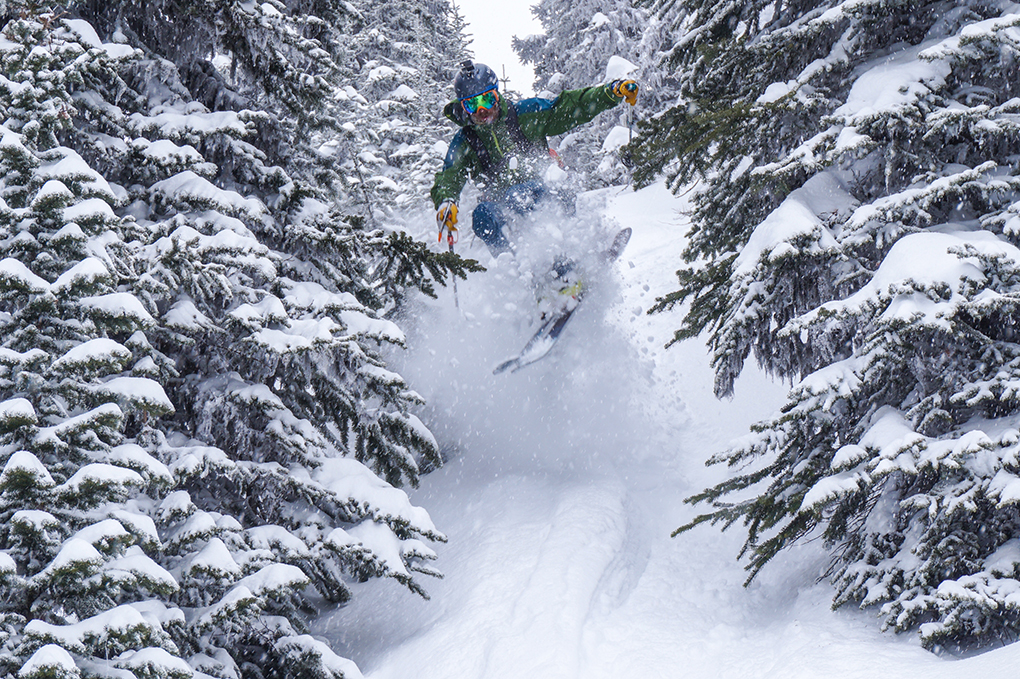
Mountain Equipment Spectre Pant
Size Tested: 34” Regular
Sizes Available: 30,32,34,36,38” waists – in Regular or Long
Blister’s Measured Weight: 627 g
Material: Gore Windstopper Soft Shell
Features:
- Mountain fit with increased lower leg volume for ski boots
- 2 vents with YKK® zips and 1 inner zipped transceiver security pocket
- Integrated belt with double press-stud waist closure
- Removable and fully adjustable braces
- Offset ankle zips with internal gusset panel to accommodate all ski boots
- Zip-out stretch Soft Shell gaiters
- Dyneema reinforced kick strips and bonded hem for ski and crampon durability
Pockets:
- 2 zippered hand pockets
- Inner zipped transciever Pocket
MSRP: $275
Reviewer: 6’0”, 180 lbs
Days Tested: 11
Test Locations: Teton Pass & Grand Targhee backcountry, WY; Jumbo Pass, BC; Glacier National Park, MT
Intro
As I gathered equipment for the Jumbo Hut trip, the Spectre Pants were an obvious choice since, according to Mountain Equipment, they are “ultra-protective soft shell pants for ski mountaineers operating in the steepest and most technical terrain.”
Unfortunately, we were blessed with an excess of snow and a shortage of stability while at Jumbo, so I was unable to put them through their full mountaineering paces there.
However, since then I have been able to tour, climb, and ski in them in the full gamut of conditions, from icy waterfall downclimbing, to spring corn laps.
Fit
It’s notable that instead of the traditional sizing of Small, Medium, and Large, Mountain Equipment offers the Spectre in 30, 32, 34, 36, and 38” waists, and in “Regular” and “Long” lengths. I wear a 32” or 33” waist, and 34” inseam in most casual pants, and went with the 34” regular length Spectre pant.
For ski touring and ski mountaineering applications this fit was very good. The waist is just a touch large, but if I’m wearing any kind of insulating layer and a belt, it fits perfectly so I wouldn’t want to size down at all. The cuffs are a little shorter than most other snow pants I’ve used (including the Trew Roam bibs), which means that I don’t have to roll them up to keep from stepping on them when wearing street shoes.

True to its mountaineering roots, the Spectre has a slim fit through the thigh and knee, and the fit is slimmer than the Trew Roam bibs. However, the pants flair dramatically at the calves to make room for ski boots, to the point that I had someone ask if I was wearing bell bottoms when I wore the pants to casually after skiing.
That cuff flair means there is plenty of room for open buckles when touring, and should accommodate Dynafit Ultralock buckles. I’ve been able to buckle and unbuckle the cuff buckle on my Fischer Travers Carbon boots through the cuff of the pant, without having to pull them up.
For a dedicated inbounds pant I’d prefer a baggier fit, but for touring and mountaineering, the slim fit of the Spectre works very well.
Features
The Spectre is stripped down, with a minimum of pockets and features. But those it does have function well.
Belt / Braces
The Spectre comes with removeable braces (suspenders) and a belt from Mountain Equipment. Since the waist fits me pretty well, I ended up taking off the braces, which hook to three loops on the waist of the pant. While I didn’t end up using them much, for all you suspender lovers out there, they are secure and easy to adjust.
The Spectre’s removable belt is a simple webbing strap with a plastic buckle. It cinches down the waist securely, although I ended up substituting an Arcade belt, something I do on all my pants. The loops easily accommodated my Arcade Hemingway, and are wide enough that the belt can’t ride up on my waist above the pants.
Vents
The Spectre has a 23 cm long diagonal vent on the front of each thigh. These are mesh lined, with a fabric strip that keeps them from opening too far.
I developed a bit of a love-hate relationship with these vents. I’m used to unlined vents on the outside and / or inside of the thigh that open wider and allow in a lot of air. In nasty weather situations, the Spectre’s front vents are much more practical—they let in less snow, and the mesh means they don’t allow direct access for snow to wet out your base layers. I also noticed wind whipping through them less on blustery days, and they offer a higher degree of modesty if you’re just wearing boxers under your ski pants on a warm day. (My apologies to everyone I’ve scarred with my wide open, full-length thigh vents)
On the flip side, they don’t allow me to dump heat and let air circulate through my nether regions as much as vents on the inside or outside of the thigh. This is because when open, they are situated in a part of the pant that is almost always stretched flush against the thigh, so it’s impossible for breezes to draft all the way through the pant.
Long and short: the Spectre’s vents are perfect for colder situations and bad weather, but don’t provide as much ventilation on warmer days, and I found that the mesh liner would rub a little on my thighs on warm days when I wasn’t wearing a full-length base layer.
Cuffs
The Spectre’s cuffs have a high kick guard that reaches about 35 cm up the inside of the leg. It’s very durable, and so far mine show no wear. I have had snow ball up on the reinforced material here, something I haven’t experienced with any other pants. It’s not a huge issue, and others with pants with the same cuff guard material haven’t run into this issue, but especially on powder days these pants have been guilty of tracking more snow inside than I’m used to.
The inner gaiter is removeable with a zipper, and adjustable with buttons and velcro. It also features eyelets to loop a cord under the boot, and a lace hook. It’s done a good job keeping out snow in everything from my low-profile Travers Carbon to the much bigger Roxa X-Face boots. However, every few days or so, I’ve found that the zipper that holds it onto the pant works its way partly open, which means when I stick my foot into the pant it sometimes goes into the gap between the gaiter and the cuff, instead of through the cuff.
Pockets
The Spectre’s thigh pockets are mesh lined, and big enough for a phone, wallet, or energy bar, but are not very spacious.
The beacon pocket is actually located inside the right-side thigh vent. Its zipper runs parallel to the vent, but runs in the opposite direction. It fits my BCA Tracker 3 with a little extra room. Because of its location and the slimmer cut of the Spectre, the beacon pocket is a little more noticeable than that in the Trew Roam, but I very quickly got used to it. The Spectre has a small plastic D-ring in the bottom of the pocket to clip your transceiver to.
In Use
Thanks to the soft shell Gore Windstopper material, the Spectre immediately felt thicker than the Trew Roam bibs I’d been using before. But I found that they did a good job wicking and breathing.
With the Trew Roams’ vents open, there is more air moving through the pant, and so they feel cooler. However, when operating at a high output with both pants zipped up, the Spectre feels a little less clammy, probably due in part to the soft backing on its shell material. It also did a slightly better job blocking high winds, something I especially noticed when hitch-hiking laps in the back of a truck on Teton Pass.
While this is no Gore Pro hardshell, I did find that the Spectre performed very well on stormy days. The front of the thighs absorbed a little moisture on one pow day, but no water penetrated the membrane.

Most notably, I performed an interesting waterfall downclimb in Glacier National park in this pant, and while some water got in through the waist opening, they did a great job keeping me dry on the descent. I’ve also found that the Spectre dries pretty quickly.
Durability
Since this is a ski mountaineering softshell, I expected the Spectre’s durability to be above average, and so haven’t babied these pants. My second day in the pant I shimmied far up a dead tree to collect firewood, and despite snagging a lot of branches and nubs, the pants were no worse for the wear. Since then I’ve skied through a few bushes and had one unfortunate run-in with a spruce tree without any ill effect.
I have managed to cut the pant with a small hole on each cuff, outside the kick guard. I’m not sure exactly what caused these cuts, but I was surprised to find them since the rest of the pant has held up so well, and I haven’t run into a similar issue with the Roam, even though I have more days in them.
Who’s It For?
Mountain Equipment bills this as a ski mountaineering pant, and I think that is their best use. For pure winter conditions, I’d opt for a full hardshell, like Mountain Equipment’s own Diamir pant. And for warmer spring objectives, I’d be looking for something lighter and more breathable. But for a one-pant-quiver, the Spectre performs very well, and if you don’t mind the slimmer cut and limited pockets, I can say that I’ve also been very happy using mine inbounds, too.
The Spectre is also very affordable, with an MSRP of $275. That’s cheaper than the Trew Roam I’ve been using previously this winter, and while that’s not a totally fair comparison since the Roam is a ¾ hardshell bib, the Spectre is still significantly more affordable than most touring pants on the market.
Bottom Line
The Mountain Equipment Spectre is not the lightest or most breathable softshell pant out there, but it strikes a nice balance that makes it versatile in a wide range of conditions. My only significant gripe is the inner gaiter unzips too often from the rest of the pant, but this issue is small enough that I’ll continue to use the Spectre for touring and mountaineering, until rising spring temperatures call for a significantly lighter pant.

What are the key differences between softshell and hardshell outerwear garments in use?
Great comprehensive review, I’ve just ordered some for downhill alpine and winter climbing (separately) I like a jack-of-all-trades pant.